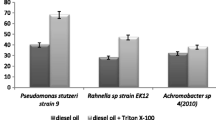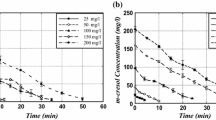Abstract
The degradation by a consortium of slightly-halophile marine bacteria of styrene initially dissolved in silicone oil was monitored in batch reactors stirred at 75, 125 and 500 rpm, respectively. In the 75 and 125 rpm cases, the styrene biodegradation rate was higher than the rate of spontaneous partitioning of styrene from the oil to the water, determined under abiotic conditions. Abiotic transfer tests carried out after biodegradation runs revealed that bacterial activity had resulted in a significant increase in the rate of styrene partitioning between the two liquid phases. Even though bacterial adsorption was noticeable at the oil-water interface, this effect appeared to be due to the release by the bacteria of chemicals in the aqueous phase. Similarity with observations made with Triton X-100 suggested that the chemicals released may have been biosurfactants or solubilizing agents.
Similar content being viewed by others
References
Ascon-Cabrera M & Lebeault JM (1993) Selection of xenobioticdegrading microorganisms in a biphasic aqueous-organic system. Appl. Environ. Microbiol. 59: 1717–1724.
Efroymson RA & Alexander M (1991) Biodegradation by an Arthrobacter species of hydrocarbons partition into an organic solvent. Appl. Environ. Microbiol. 57: 1441–1447.
Efroymson RA & Alexander M (1994) Role of partitioning in biodegradation of phenanthrene dissolved in nonaqueous-phase liquids. Environ. Sci. Technol. 28: 1172–1179.
El Aalam S, Pauss A & Lebeault JM (1993) High efficiency styrene biodegradation in a biphasic organic/water continuous reactor. Appl. Microbiol. Biotechnol. 39: 696–699.
Käppeli O, Walther P, Mueller M & Fiechter A (1984) Structure of the cell surface of the yeast Candida tropicalis and its relation to hydrocarbon transport. Arch. Microbiol. 138: 279–292.
Ortega-Calvo JJ & Alexander M (1994) Roles of bacterial attachment and spontaneous partitioning in the biodegradation of naphthalene initially present in nonaqueous-phase liquids. Appl. Environ. Microbiol. 60: 2643–2646.
Osswald P, Courtès R, Bauda P, Block JC, Bryers JD & Sunde E (1995) Xenobiotic biodegradation test using attached bacteria in synthetic seawater. Ecotox. Environ. Safety 31: 211–217.
Rosenberg M, Bayer EA, Delarea J & Rosenberg E (1982) Role of thin fimbriae in adherence and growth of Acinetobacter calcoaceticus RAG-1 on hexadecane. Appl. Environ. Microbiol. 44: 929–937.
Rosenberg M, Gutnick D & Rosenberg E (1980) Adherence of bacteria to hydrocarbons: a simple method for measuring hydrophobicity. FEMS Microbiol. Lett. 9: 29–33.
Zhang Y & Miller RM (1992) Enhanced octadecane dispersion and biodegradation by a Pseudomonas rhamnolipid surfactant (biosurfactant). Appl. Environ. Microbiol. 58: 3276–3282.
Zhang Y & Miller RM (1994) Effect of a rhamnolipid biosurfactant on cell hydrophobicity and biodegradation of octadecane. Appl. Environ. Microbiol. 60: 2101–2106.
Author information
Authors and Affiliations
Rights and permissions
About this article
Cite this article
Osswald, P., Baveye, P. & Block, J.C. Bacterial influence on partitioning rate during the biodegradation of styrene in a biphasic aqueous-organic system. Biodegradation 7, 297–302 (1996). https://doi.org/10.1007/BF00115743
Accepted:
Issue Date:
DOI: https://doi.org/10.1007/BF00115743




